Most Common Wildflowers: An In-Depth Examination
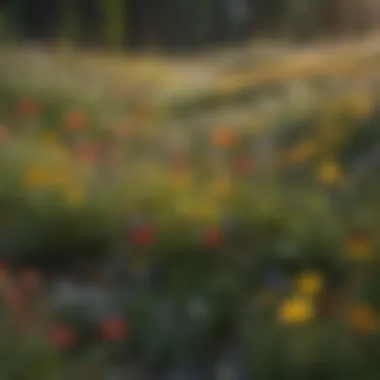

Intro
Wildflowers form a vital part of our ecosystems, showcasing a diverse array of species that contribute to the ecological balance of our environment. This article aims to provide detailed insights into the most common wildflowers encountered in different ecosystems. By understanding their characteristics, ecological roles, and cultural significance, readers can appreciate the complexity of these plants as well as their importance to biodiversity. This knowledge fosters an awareness that can lead to better conservation practices.
Understanding Woodland Ecosystems
Importance of Biodiversity in Forests
Biodiversity in forests is crucial. It supports various life forms, enhances ecosystem resilience, and promotes overall health in our natural surroundings. Different wildflower species offer essential habitats and food sources for insects, birds, and other wildlife.
Among these wildflowers are species like the Trillium and Goldenseal, often found in rich and shaded areas. These plants not only contribute to the aesthetic of woodlands but also play a key role in soil stabilization and nutrient cycling. Limiting the diversity of floral species can threaten the entire food chain within forests.
Role of Forests in Climate Regulation
Forests serve as significant carbon sinks. Wildflowers, although often overlooked, contribute to the overarching health of forests. Their presence supports processes that help reduce atmospheric carbon dioxide levels. They also assist in maintaining humidity and creating favorable microclimates for various organisms. By nurturing robust wildflower populations, we support the ecological integrity of forests and, consequently, climate regulation.
"Healthy ecosystems are foundational for sustainable development."
Sustainable Forestry Practices
Principles of Sustainable Forestry
Sustainable forestry encompasses practices that prioritize the long-term health of forest ecosystems. These practices include selective logging, maintaining biodiversity, and protecting water quality. Recognizing the significance of wildflowers is a key component of these principles.
For instance, promoting diverse understory plants helps maintain soil health and prevents erosion. Sustainable methods help ensure that ecosystems remain viable for future generations while still providing economic opportunities for communities.
Case Studies of Successful Implementations
One notable case is the Appalachian Trail Conservancy's efforts in managing forest habitats that support local wildflower species. Their programs highlight reforestation and controlled growth to promote the flourishing of native wildflowers. Likewise, the North Carolina Forest Service has made strides in integrating educational programs aimed at fostering appreciation and understanding of local flora in their forestry practices. These examples serve as models for balancing ecological health and economic benefits in forestry.
Woodland Stewardship Techniques
Forest Management Plans
A well-structured forest management plan is essential for conservation. Such plans often incorporate strategies to enhance habitat quality for wildflowers while providing guidelines for responsible land use.
Wildflower plantings can be an integral part of these management plans, aimed at restoring native species and improving biodiversity. They also offer educational opportunities to engage communities in conservation efforts.
Conservation Strategies
Developing effective conservation strategies involves protecting existing habitats and restoring degraded areas. Strategies may include invasive species control to allow native wildflowers to thrive. Incorporating natives into landscaping can promote ecosystem health in urban areas as well.
In summary, wildflowers are not just decorative species; they embody ecological significance that supports healthy woodland ecosystems. By enhancing our understanding of their roles, we can promote practices that nurture both wildflowers and the overall environment.
Prelims to Wildflowers
Understanding wildflowers is essential for both enthusiasts and professionals in forestry and ecology. Wildflowers enhance ecosystems, supporting various forms of life and adding beauty to natural landscapes. They are often indicators of environmental health, and their presence can highlight specific ecological conditions.
Definition and Importance
Wildflowers are flowering plants that grow naturally without human intervention. They offer a rich variety of colors, shapes, and sizes, contributing significantly to biodiversity. In a broader sense, wildflowers are crucial for maintaining ecological balance. Their role in providing habitats for insects, birds, and other wildlife cannot be overstated.
Wildflowers also contribute to human culture. Many have historical significance in traditional medicine or have been used in landscaping and gardening. Their aesthetic value supports well-being and promotes tourism, proving that their importance extends far beyond their natural existence.
Ecological Significance
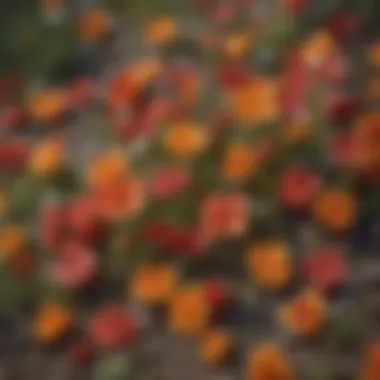
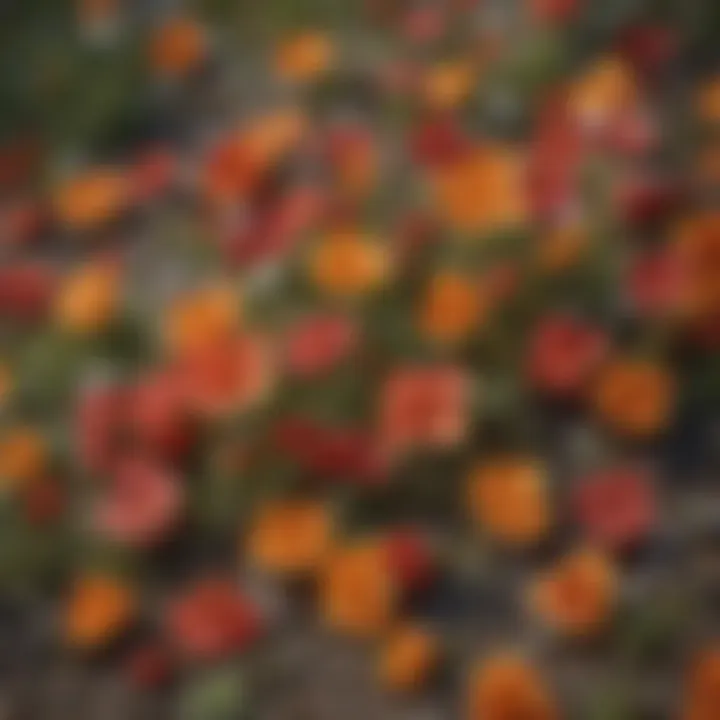
The ecological significance of wildflowers is profound. They provide essential food sources for pollinators, such as bees and butterflies. This relationship forms a critical part of the food web, ensuring the survival of various species. Without wildflowers, many ecosystems would suffer from decreased biodiversity.
Wildflowers play a key role in soil health, erosion control, and water cycle regulation.
In addition to supporting pollinators, wildflowers contribute to soil fertility. Their root systems can help anchor soil, reducing erosion risks during heavy rains. This makes them vital for preventing land degradation. Furthermore, wildflowers can improve soil structure and nutrient levels, benefiting the growth of other plants in the ecosystem.
Wildflower Identification
Understanding how to identify wildflowers is crucial for appreciation and conservation. Accurate identification enables us to recognize the variety of species existing within our ecosystems. This knowledge is not only vital for biodiversity studies but also serves practical purposes for land management, horticulture, and education. Through learning the distinctive characteristics of wildflowers, enthusiasts can contribute more effectively to conservation efforts and promote awareness of local flora.
Key Identification Features
When identifying wildflowers, several features come into play. These include:
- Flower Structure: The shape, size, and color of the flower help differentiate species. For instance, daisies exhibit a composite flower structure with numerous small florets.
- Leaf Arrangement: Observing how leaves grow on the stem is essential. Some might be alternately arranged, while others exhibit opposite or whorled patterns.
- Height and Growth Habit: Noting the overall height and growth forms assists in recognizing the species. For example, foxgloves are tall, upright plants, while buttercups are typically shorter and spread across the ground.
- Habitat Preferences: Certain wildflowers thrive in specific environments. Understanding the habitats—such as wetlands, grasslands, or woodlands—helps narrow down potential species.
Familiarizing oneself with these features enhances the ability to accurately identify wildflowers in the field, enriching one’s understanding of plant diversity.
Common Identification Resources
Finding reliable resources can aid individuals in their wildflower identification journey. Some effective tools include:
- Field Guides: Books specific to wildflower identification often provide detailed photographs and descriptions. Guides such as Field Guide to the Wildflowers of North America can be particularly helpful.
- Online Databases: Websites like Wikipedia and Britannica offer accessible information about various plants.
- Mobile Apps: Using apps like PlantSnap and Seek allows users to take photos of plants for instant identification. These tools use artificial intelligence to match images with known species.
- Local Botanical Gardens or Nurseries: Engaging with local experts provides direct knowledge about regional flora. Many institutions host workshops and guided walks to assist in plant identification.
These resources facilitate deeper understanding and proficient identification of wildflowers across different regions.
Habitat and Distribution
Understanding the habitat and distribution of wildflowers is crucial for several reasons. First, it allows us to identify which species thrive in certain environments. This knowledge can inform conservation efforts as restoring or preserving habitats is key to protecting these plants. Moreover, assessing the distribution of wildflowers helps us appreciate their role in various ecosystems, contributing to biodiversity and supporting different wildlife. Each flower serves as a resource, whether as food, shelter, or as part of a larger ecological network.
Types of Habitats
Wildflowers can be found in a variety of habitats, each fostering specific conditions that influence their growth and survival. Here are some common types of habitats where wildflowers thrive:
- Grasslands: This habitat features open spaces with abundant sunlight and well-drained soil. Grassland wildflowers, like the buttercup, flourish in these conditions where competition is primarily from grasses.
- Woodlands: Understory layers in forests provide a unique microhabitat. Wildflowers such as bluebells often emerge before tree leaves fully expand, capturing sunlight.
- Wetlands: These areas provide constant moisture and are home to species like the marsh marigold. Wetland habitats support a diverse range of flora and fauna.
- Coastal Areas: Here, salt-tolerant species can be found. Wildflowers such as seaside goldenrod adapt to the challenges of wind and salt spray.
- Desert: In harsh conditions with sparse water, wildflowers like desert hyacinth emerge after rare rainfall. They have adaptations for survival in extreme weather.
These diverse habitats highlight the adaptability of wildflowers to different environmental conditions, enhancing their significance across landscapes.
Geographical Distribution
Geographical distribution of wildflowers varies significantly across different regions. This distribution is often influenced by climate, soil type, elevation, and human activity.
- North America: In the United States, the Rockies' alpine meadows play host to unique species like the alpine aster, while the eastern forests are rich in species such as the trillium.
- Europe: In Europe, wildflowers like the daisy and hedgerow flora flourish in temperate climates, adapting to both coastal and mainland conditions.
- Asia: The extensive Himalayan range is home to rare species adapted to extreme altitude. Other regions in Asia vary widely from deserts to lush forests, each hosting diverse wildflowers.
- Afria: From the savannah plains where wildflowers like the African daisy grow, to the rich biodiversity found in the Cape Floral Kingdom, wildflowers are essential in these ecosystems.
Monitoring geographical distribution aids in understanding the health of ecosystems and the impact of climate change on these species. Given these factors, awareness of geographical distribution is vital for ongoing conservation efforts.
Most Common Wildflowers
Understanding the common wildflowers that populate various landscapes is vital for both ecological health and human connection to nature. In this section, we explore several wildflower species, each offering unique contributions to their ecosystems and the cultural fabric of human life. By examining these flowers, we also highlight their identification features, distribution, and growth conditions.
Daisy
Ecological Role
Daisies play a significant role in attracting pollinators, particularly bees and butterflies. Their abundant nectar provides essential food for these creatures, promoting the overall health of local ecosystems. Additionally, daisies can improve soil quality by breaking up compacted ground, enhancing conditions for other plants to grow.
Cultural Significance
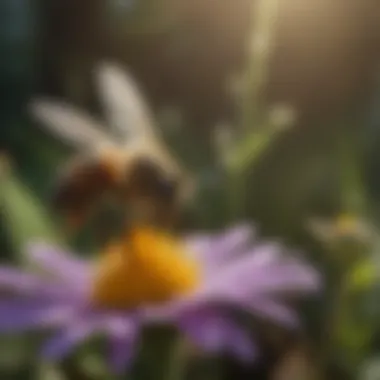
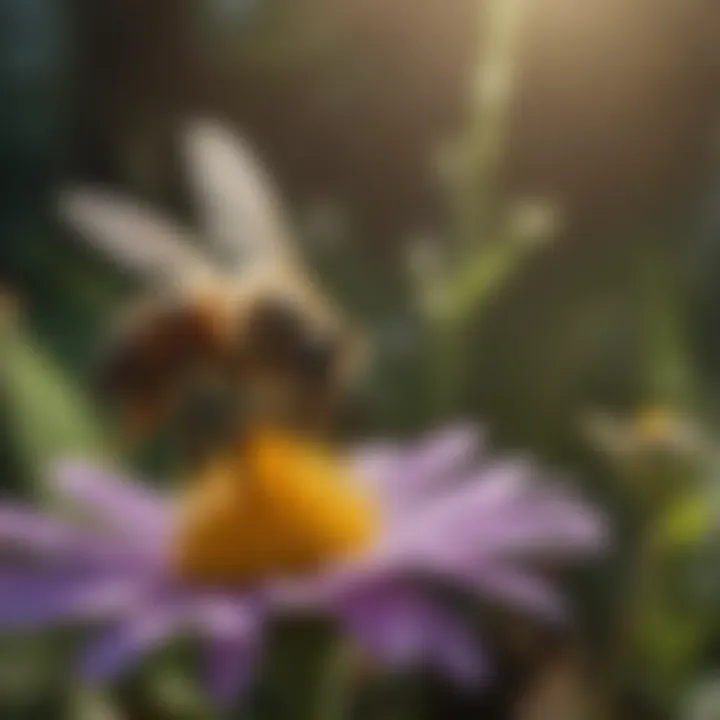
Daisies hold a place in various cultural narratives. Often symbolizing innocence and purity, they appear in literature and art throughout history. Their accessibility and beauty have made them a popular choice in gardens and floral arrangements, further bridging the connection between humans and nature.
Bluebell
Ecological Role
These flowers are essential for nurturing the life cycles of various pollinators, especially solitary bees. By providing nectar early in the year, bluebells support these insects when food sources are scarce. They also indicate healthy woodland environments through their sensitivity to changes in habitat quality.
Cultural Significance
Bluebells often feature in folklore and poetry, symbolizing love and humility. They attract attention in spring and have become emblematic of English woodlands. Gardens feature them for their beauty, yet care must be taken to ensure they are not harvested from the wild, preserving their natural habitats.
Buttercup
Ecological Role
Buttercups are important for many herbivorous animals as they provide necessary forage. Although these flowers are somewhat toxic to livestock, they form a crucial part of the food web, supporting various pollinators and pests, which are part of the ecosystem.
Cultural Significance
In many cultures, buttercups are associated with childhood and simplicity. They often appear in games—placing a buttercup under someone's chin to see if they like butter. Beyond this, they symbolize nostalgia and the fleeting nature of youth.
Foxglove
Ecological Role
Foxgloves are valuable for attracting bumblebees, which are crucial for pollination. The flowers' design allows bees to efficiently access nectar, contributing to the health of local ecosystems. They support soil stabilization, preventing erosion in their preferred habitats.
Cultural Significance
Historically, foxgloves have been associated with various folklore, often depicting them as magical or mystical plants. In modern herbalism, they are recognized for their medicinal properties, particularly in heart conditions, highlighting the intersection of nature and health.
Lupine
Ecological Role
Lupines contribute significantly to their ecosystems by enhancing soil fertility. Their ability to enrich the soil benefits neighboring plant species. They are also an important source of nectar for bees and butterflies, supporting pollinator populations in various habitats.
Cultural Significance
Lupines are admired not only for their beauty but also for their symbolism of perseverance and determination, often featured in art and poetry. Their presence in gardens symbolizes a commitment to biodiversity and sustainability.
Poppy
Ecological Role
Poppies are important for their role in attracting various pollinators. They provide sustenance for bees and butterflies, particularly during late spring and early summer, feeding several species at a crucial time. Their ability to thrive in poor soil conditions makes them essential for rehabilitating degraded land.
Cultural Significance
In many cultures, poppies symbolize remembrance, particularly associated with war memorials. They serve as a poignant reminder of sacrifice, especially in the context of World War I. The poppy’s dual nature as both a beautiful flower and a symbol of loss illustrates its complex role in human narratives.
Growth Conditions
Understanding the growth conditions for wildflowers is crucial for their successful cultivation and conservation. The environment, including soil, sunlight, and water, directly affects the health and vitality of these plants. Knowing these conditions facilitates better gardening practices and helps sustain local ecosystems. Particularly in specific habitats, the right combination of these factors can enhance biodiversity, creating a rich tapestry of flora that supports various fauna. Thus, fostering knowledge about these growth conditions aids not only enthusiasts but also professionals aiming to restore or manage natural landscapes effectively.
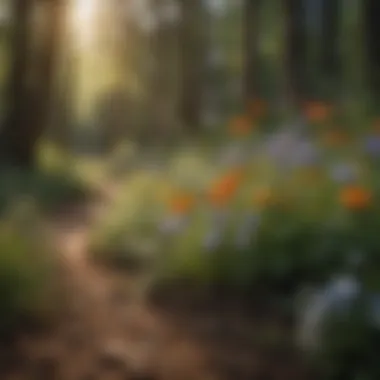

Soil Requirements
Soil quality is vital when considering wildflower growth. Different wildflowers have specific soil preferences. These conditions can include texture, pH, and nutrient content. For instance, some species thrive in sandy soil with good drainage, while others may prefer clayey substrates that retain moisture.
A well-balanced soil creates an environment conducive to strong root development and nutrient uptake. Therefore, before planting, assess the soil's characteristics. Conducting a soil test can inform amendments needed to optimize growing conditions. Key soil considerations include:
- pH Level: Most wildflowers prefer a neutral pH between 6.0 and 7.0, but some species can grow in more acidic or alkaline soils.
- Nutrient Content: Fertile soil enriched with organic matter supports healthier plants.
- Drainage Characteristics: Good drainage prevents root rot while maintaining enough moisture for growth.
Sunlight Preferences
Wildflowers exhibit varying requirements for sunlight, which is a critical component in their growth. Sunlight affects photosynthesis, the process through which plants convert light into energy. Understanding these preferences ensures that wildflowers receive adequate light for optimal growth.
Wildflowers can generally be categorized based on their sunlight needs:
- Full Sun: Some wildflowers require at least six hours of direct sunlight each day. Examples include Daisy and Poppy.
- Partial Shade: Many wildflowers flourish with only a few hours of sunlight and will tolerate shadier conditions, such as Bluebell.
- Full Shade: A select few species adapt to low-light environments, thriving under tree canopies or among dense foliage.
Water Needs
Water availability is another pivotal factor in growing wildflowers. Most wildflowers do not require excessive watering once established; however, understanding their water needs is essential.
Each species can have unique water requirements. Some wildflowers thrive in moist conditions, while others prefer dry, drought-tolerant environments. Here are some important points regarding wildflower water needs:
- Establishment Period: Newly planted wildflowers generally require more frequent watering until they establish
- Drought Resistance: Certain wildflower species, such as Lupine and Buttercup, are adapted to survive in conditions with limited water.
- Irrigation Practices: Regular but moderate watering can encourage robust growth without creating overly saturated conditions.
"If we understand the specific growth conditions of wildflowers, we can better support their beautiful existence in our natural landscapes."
Wildflower Conservation
Wildflower conservation is a critical aspect of maintaining biodiversity and ensuring the sustainability of ecosystems. As various species of wildflowers play significant roles within their habitats, preserving these plants becomes vital not just for their existence, but also for the ecological balance of the areas they inhabit. Wildflowers serve as food sources for countless pollinators, such as bees and butterflies. They also contribute to soil health, prevent erosion, and provide habitat for many other organisms.
Threats to Wildflowers
Understanding the threats to wildflowers is key to conservation efforts. Several factors endanger wildflower populations:
- Habitat Loss: Urbanization, agriculture, and land development destroy the natural habitats where wildflowers grow.
- Invasive Species: Non-native plants can outcompete wildflowers for resources, leading to declines in native populations.
- Climate Change: Alterations in temperature and precipitation patterns can affect growth conditions for wildflowers.
- Pollution: Chemical run-off and air pollutants can harm wildflower health and reduce their reproductive success.
- Overharvesting: Picking or extracting wildflowers for ornamental or medicinal purposes can deplete populations in their natural environments.
"Preservation of wildflowers directly correlates with the health of entire ecosystems. Without them, many species, including ourselves, face dire consequences."
Conservation Strategies
Conservation strategies for wildflowers are essential in mitigating the threats they face. They include:
- Habitat Restoration: Efforts to restore native plant communities can help revive ecosystems where wildflowers have declined.
- Education and Awareness: Increasing public awareness about the importance of wildflowers can engage communities in conservation efforts.
- Seed Conservation: Collecting and storing seeds from native wildflowers ensures genetic diversity and availability for future planting.
- Legislation: Enacting laws to protect natural habitats and regulate the trade of wildflowers aids in their conservation.
- Research and Monitoring: Continuous study of wildflower populations and their ecosystems provides vital data to inform conservation actions.
The conservation of wildflowers is fundamentally tied to the health of the environment. By implementing effective conservation strategies, we can safeguard wildflowers and, consequently, the biodiversity that relies upon them.
End
In summation, the exploration of wildflowers presented in this article underscores their critical role in maintaining the balance within various ecosystems. Wildflowers not only enhance biodiversity but also serve as key indicators of the health of their environments. Their presence can signal changes in ecological conditions, adapting to their habitat requirements and offering a wealth of benefits to other species.
Summary of Findings
Throughout the sections, we have observed several vital points regarding common wildflowers. Firstly, each species studied has distinct identification characteristics that help in proper recognition and preservation efforts. For instance, the Daisy, Bluebell, Buttercup, Foxglove, Lupine, and Poppy are not merely visually appealing; they contribute significantly to local ecosystems through pollinator support and soil stabilization. Wildflowers are also well-adapted to specific growth conditions, requiring particular types of soil, sunlight, and water to thrive. Moreover, the cultural significance of these flowers has been highlighted in various traditions, adding to their profound value in human history.
The Importance of Wildflower Preservation
Preserving wildflowers and their habitats is essential not just for their continued existence but for the overall ecological integrity. As highlighted, wildflowers face numerous threats such as habitat destruction, invasive species, and climate change. Without targeted conservation strategies, many species may face extinction, further reducing biodiversity.
To ensure their survival, it is crucial to foster awareness and implement effective conservation plans. This includes:
- Engaging with local communities to promote the planting of native wildflower species.
- Supporting policies that protect natural habitats.
- Educating the public about the importance of biodiversity and ecosystems.
"Wildflowers serve as a reminder that beauty and functionality can coexist in the natural world."







